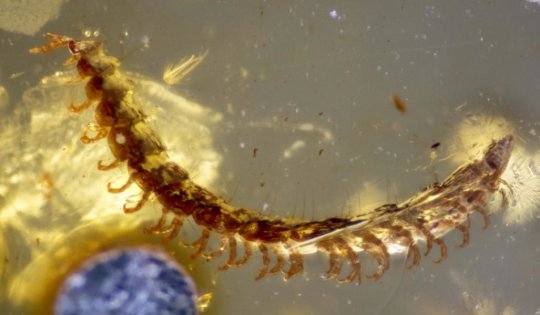[ad_1]
Since the success of the Jurassic Park film series, it is widely known that insects from the Age of the Dinosaurs can be found exceptionally well preserved in amber, which is in fact fossilised tree resin.
Especially diverse is the animal fauna preserved in Cretaceous amber from Myanmar (Burma). Over the last few years, the almost 100-million-year-old amber has revealed some spectacular discoveries, including dinosaur feathers, a complete dinosaur tail, unknown groups of spiders and several long extinct groups of insects.
However, as few as three millipede species, preserved in Burmese amber, had been found prior to the study of Thomas Wesener and his PhD student Leif Moritz at the Zoological Research Museum Alexander Koenig — Leibniz Institute for Animal Biodiversity (ZFMK). Their research was recently published in the open-access journal Check List.
Having identified over 450 millipedes preserved in the Burmese amber, the scientists confirmed species representing as many as 13 out of the 16 main orders walking the Earth today. The oldest known fossils for half of these orders were found within the studied amber.
The researchers conducted their analysis with the help of micro-computed tomography (micro-CT). This scanning technology uses omni-directional X-rays to create a 3D image of the specimen, which can then be virtually removed from the amber and digitally examined.
The studied amber is mostly borrowed from private collections, including the largest European one, held by Patrick Müller from Käshofen. There are thought to be many additional, scientifically important specimens, perhaps even thousands of them, currently inaccessible in private collections in China.
Over the next few years, the newly discovered specimens will be carefully described and compared to extant species in order to identify what morphological changes have occurred in the last 100 million years and pinpoint the speciation events in the millipede Tree of Life. As a result, science will be finally looking at solving long-standing mysteries, such as whether the local millipede diversity in the southern Alps of Italy or on the island of Madagascar is the result of evolutionary processes which have taken place one, ten or more than 100-million years ago.
According to the scientists, most of the Cretaceous millipedes found in the amber do not differ significantly from the species found in Southeast Asia nowadays, which is an indication of the old age of the extant millipede lineages.
On the other hand, the diversity of the different orders seems to have changed drastically. For example, during the Age of the Dinosaurs, the group Colobognatha — millipedes characterised by their unusual elongated heads which have evolved to suck in liquid food — used to be very common. In contrast, with over 12,000 millipede species living today, there are only 500 colobognaths.
Another curious finding was the discovery of freshly hatched, eight-legged juveniles, which indicated that the animals lived and reproduced in the resin-producing trees.
“Even before the arachnids and insects, and far ahead of the first vertebrates, the leaf litter-eating millipedes were the first animals to leave their mark on land more than 400-million-years ago,” explain the scientists. “These early millipedes differed quite strongly from the ones living today — they would often be much larger and many had very large eyes.”
The larger species in the genus Arthropleura, for example, would grow up to 2 m (6.5 ft) long and 50-80 cm (2-3 ft) wide — the largest arthropods to have ever crawled on Earth. Why these giants became extinct and those other orders survived remains unknown, partly because only a handful of usually badly preserved fossils from the whole Mesozoic era (252-66-million years ago) has been retrieved. Similarly, although it had long been suspected that the 16 modern millipede orders must be very old, a fossil record to support this assumption was missing.
Story Source:
Materials provided by Pensoft Publishers. The original story is licensed under a Creative Commons License. Note: Content may be edited for style and length.
[ad_2]















